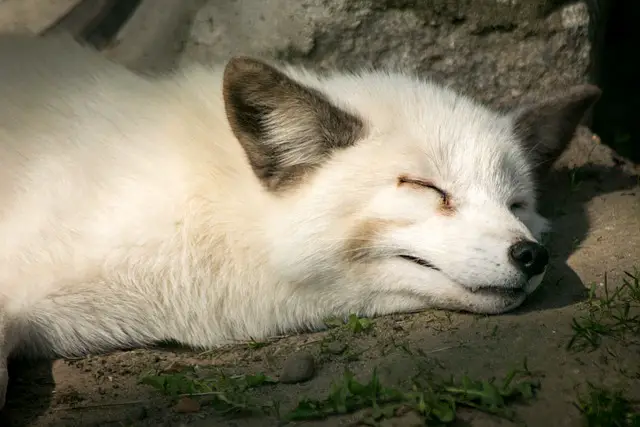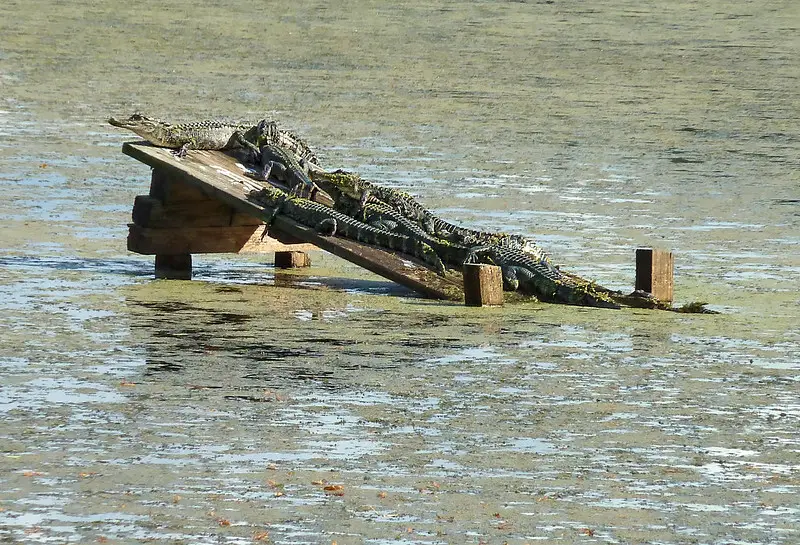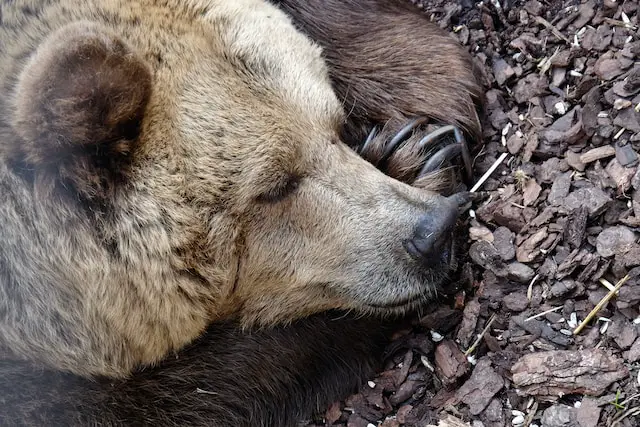Not all animals have the luxury of hibernating or brumating. Some species are unable to enter these states due to physiological and environmental factors. For instance, animals that live in areas with mild winters may not need to hibernate or brumate as they can find food year-round. Similarly, some aquatic animals such as fish and turtles do not undergo true hibernation as their metabolism doesn’t slow down significantly during winter.
Hibernation
(Image by Thorsten Frenzel from Pixabay )

Hibernation is a survival strategy used by many animals to conserve energy during the winter months. It involves slowing down their metabolism and reducing body temperature to save energy when food is scarce. During hibernation, an animal’s heart rate and breathing slow down significantly, making it appear as though they are sleeping.
The process of hibernation is triggered by changes in daylight hours and temperature. As the days get shorter and colder, animals begin to store fat reserves that will sustain them throughout the winter. Hibernating animals typically find a safe spot such as a burrow or den to sleep through the cold months.
Not all animals hibernate for the same amount of time; some may only do so for a few weeks while others can remain dormant for several months. Black bears, chipmunks, hedgehogs are just some examples of mammals that go into true hibernation.
Interestingly enough, not all animals need to hibernate in order to survive harsh winters; some species have adapted different ways of surviving without entering into true hibernation mode like birds who migrate south or adapt their diets accordingly
Brumation

Brumation is a term that describes the state of inactivity or dormancy exhibited by some reptiles during the winter months. Unlike hibernation, brumation does not involve a profound reduction in metabolic activity but rather a slowing down of bodily processes. This means that while animals that hibernate can go without food and water for extended periods, those undergoing brumation may still eat and drink if they choose to.
During this period, reptiles will typically find a safe and sheltered place where they can remain undisturbed until temperatures rise again in the springtime. They will often bury themselves underground or seek refuge inside rock crevices or hollow logs.
Despite its similarities to hibernation, brumation differs from species to species depending on factors such as location, climate and diet. Some reptiles may experience partial brumation while others may enter into it fully with no movement at all for weeks on end.
Understanding how different animals cope with changing seasons remains an exciting field of research with many fascinating discoveries still waiting to be made about these remarkable creatures!
Hibernation Vs. Brumation – Key differences
Hibernation and brumation may sound similar, but they are actually quite different. The key difference between the two is their purpose. Hibernation occurs in response to cold temperatures and a lack of food, while brumation happens as a result of hot temperatures or drought conditions.
During hibernation, animals go into a deep sleep-like state where their body temperature drops significantly. This allows them to conserve energy during periods when food is scarce. In contrast, during brumation, animals slow down their metabolism but remain awake and alert.
Another important difference between these two states is how long they last for different species. Some animals hibernate for several months at a time while others only do so briefly. On the other hand, many reptiles can spend up to six months in brumation depending on environmental factors.
It’s also worth noting that not all animals hibernate or brumate because there are some who simply don’t need to due to their ability to adapt quickly to changing weather conditions.
Understanding the differences between hibernation and brumation can help us better appreciate the unique ways that different animal species have evolved over time in order to survive harsh climates and unpredictable environments.
The science behind hibernation and brumation
The science behind hibernation and brumation is fascinating. During hibernation, an animal’s metabolism slows down significantly, allowing them to conserve energy during the winter months when food is scarce.
This metabolic slowdown leads to a decrease in body temperature and heart rate, which helps animals survive without food for extended periods. In contrast, during brumation, reptiles enter a state of reduced activity but do not experience the same drop in body temperature as hibernating animals.
Scientists believe that both processes are controlled by specific genes that trigger changes in hormone levels and cellular metabolism. These changes allow animals to adapt to their environment and survive harsh conditions.
Interestingly, some species can even go through cycles of torpor or arousal throughout the winter season depending on environmental factors such as temperature or light exposure. The mechanisms behind these cycles remain under investigation by researchers.
Understanding the science behind hibernation and brumation can help us appreciate how animals have evolved unique survival strategies for different environments.
Animals that hibernate
Many animals hibernate during the winter months when food is scarce and temperatures drop. Hibernation allows animals to conserve energy, maintain their body temperature and survive until spring arrives.
One example of an animal that hibernates is the bear. During hibernation, bears can decrease their heart rate and respiratory rate, which slows down their metabolism and helps them conserve energy. They may also enter a state of torpor where they are not fully asleep but are in a state of reduced activity.
Another animal that hibernates is the hedgehog. Hedgehogs will typically begin preparing for hibernation in late autumn by building up fat reserves so they can survive through the winter without eating or drinking.
Other animals that commonly hibernate include bats, chipmunks, ground squirrels, and some species of snakes.
It’s important to note that not all animals are able to successfully go into hibernation as it requires specific adaptations such as being able to store enough body fat or lower metabolic rates. Additionally, some species have evolved alternative strategies like migrating instead of entering into a state of dormancy during colder weather conditions.
Animals that brumate
Brumation is the process of dormancy that reptiles, amphibians, and some mammals undergo during winter. Unlike hibernation, brumation can occur in warmer temperatures where the animal’s metabolic rate slows down to conserve energy.
Reptiles such as snakes, lizards, and turtles are known to brumate. During this time, they become less active and may stop eating altogether. Some species even bury themselves underground or in leaf litter to regulate their body temperature.
Amphibians like frogs also enter a period of dormancy during winter called “freeze tolerance.” They produce natural antifreeze chemicals that prevent ice crystals from forming inside their cells when they freeze.
Mammals that brumate include bats and some species of rodents like groundhogs. These animals lower their metabolic rates to survive through winter without food by entering into a state of torpor similar to hibernation but with periods of arousal in between.
Brumating animals have evolved unique adaptations that help them survive harsh winters with little food available. It’s fascinating how these creatures slow down their bodies’ functions while still being able to wake up periodically for essential activities!
How does hibernation or brumation benefit animals?
Hibernation and brumation are both mechanisms that help animals conserve energy during times of scarcity. By reducing their metabolic rate, these animals can survive without food or water for extended periods.
During hibernation, the animal’s body temperature drops significantly which slows down its metabolism. This helps to conserve energy while allowing the animal to remain inactive throughout winter when food is scarce. In contrast, during brumation the metabolic rate doesn’t drop as much as in hibernation since some reptiles need to maintain a slightly higher internal temperature.
The benefits of hibernation and brumation are multiple. Firstly it allows animals to avoid harsh environmental conditions such as extreme cold temperatures or droughts. Secondly, by conserving energy they can survive long periods without eating or drinking; this could be crucial especially for those who live in areas where resources are scarce.
Furthermore, these processes also enable animals to avoid predation since they become less active and therefore less vulnerable prey. Moreover, it enables them to emerge from their period of torpor with renewed vigor ready for reproduction and growth if necessary.
Hibernating or Brumating is an efficient way for certain species of mammals and reptiles alike to cope with challenging environmental conditions while ensuring their survival until better times arrive.
Why do some animals choose not to hibernate or brumate?
Moreover, many tropical species don’t experience significant seasonal changes in temperature or food availability, making hibernation unnecessary for them.
In contrast, some species cannot physically enter a state of torpor because their bodies lack the necessary adaptations. For example, birds must maintain a high body temperature for flight and therefore cannot lower it enough for torpor without risking death.
Ultimately, whether an animal chooses to hibernate or brumate depends on its specific ecological niche and evolutionary history. The decision is influenced by various factors such as climate conditions and available resources.
featured Image By – Daniele Levis Pelusi on Unsplash







